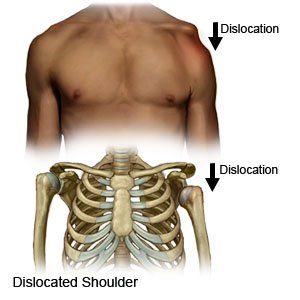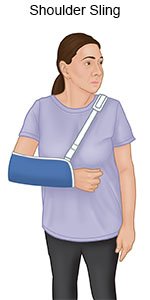Shoulder Dislocation
Medically reviewed by Drugs.com. Last updated on Apr 6, 2025.
What is a shoulder dislocation?
A shoulder dislocation happens when the top of your arm bone (humerus) moves out of the socket in your shoulder blade. Shoulder dislocation can happen at any age but is not common in younger children.
 |
What are the signs and symptoms of a shoulder dislocation?
- Shoulder and arm pain that worsens with movement
- A bump in front of or behind your shoulder
- Different shapes for each shoulder
- Redness and swelling in your shoulder
- Muscle spasms in your shoulder
- Weakness, numbness, or tingling in your shoulder and arm
How is a shoulder dislocation diagnosed?
Your healthcare provider will ask about your signs and symptoms. He or she will compare the shape of your shoulders. He or she may touch areas of your shoulder and arm to see if you have decreased feeling. Your provider may also check your arm strength and movement. Tell him or her if you have had a shoulder dislocation in the past. You may also need the following:
- X-ray, CT, or MRI pictures may be taken to look at the bones in your shoulder or to check for tissue damage. You may be given contrast liquid before the pictures are taken to help healthcare providers see the pictures better. Tell the healthcare provider if you have ever had an allergic reaction to contrast liquid. Do not enter the MRI room with anything metal. Metal can cause serious injury. Tell the healthcare provider if you have any metal in or on your body.
- An arthrogram is an x-ray taken after contrast liquid is injected into your injured joint. This test is used to look at the bones and muscles in your shoulder joint. Tell the healthcare provider if you have ever had an allergic reaction to contrast liquid.
How is a shoulder dislocation treated?
Treatment depends on how badly your shoulder is dislocated, and if bone or tissue is damaged. You may need any of the following:
- Manual reduction is used to move your dislocated humerus back into place by hand. Weights may also be used to help pull your humerus into place.
- Prescription pain medicine may be given. Ask your healthcare provider how to take this medicine safely. Some prescription pain medicines contain acetaminophen. Do not take other medicines that contain acetaminophen without talking to your healthcare provider. Too much acetaminophen may cause liver damage. Prescription pain medicine may cause constipation. Ask your healthcare provider how to prevent or treat constipation.
- A sling, splint, or brace may be needed after your shoulder dislocation is treated. A sling or splint will limit shoulder movement while supporting it. A brace protects your shoulder from injury after treatment. Ask your healthcare provider for more information about slings, splints, and braces.

- Physical therapy may be used to teach you exercises to help improve movement and strength, and to decrease pain.
- Surgery may be needed to repair damaged tissues around your shoulder joint. You may also need a bone graft to repair your shoulder. A bone graft is artificial bone used to replace your damaged bone. You may also need surgery if your shoulder dislocates often.
What can I do to care for my shoulder?
- Apply ice to your shoulder. Ice helps decrease swelling and pain. Ice may also help prevent tissue damage. Use an ice pack, or put crushed ice in a plastic bag. Cover it with a towel before you place it on your shoulder. Apply ice for 15 to 20 minutes every hour or as directed.
- Rest your shoulder. Rest helps your muscles and tissues heal. Avoid activities that cause pain or use an overhead arm motion. Your healthcare provider will tell you when it is safe to return to sports or other daily activities.
When should I seek immediate care?
- Your shoulder and arm become pale or cold.
- You cannot move your shoulder and arm.
- You have more redness or swelling in your shoulder.
- Your shoulder becomes dislocated again.
When should I call my doctor?
- You have a fever.
- You have more pain in your shoulder and arm even after you rest and take your medicine.
- You have new weakness or numbness in your shoulder and arm.
- You have questions or concerns about your condition or care.
Care Agreement
You have the right to help plan your care. Learn about your health condition and how it may be treated. Discuss treatment options with your healthcare providers to decide what care you want to receive. You always have the right to refuse treatment. The above information is an educational aid only. It is not intended as medical advice for individual conditions or treatments. Talk to your doctor, nurse or pharmacist before following any medical regimen to see if it is safe and effective for you.© Copyright Merative 2025 Information is for End User's use only and may not be sold, redistributed or otherwise used for commercial purposes.
Learn more about Shoulder Dislocation
Care guides
Further information
Always consult your healthcare provider to ensure the information displayed on this page applies to your personal circumstances.
